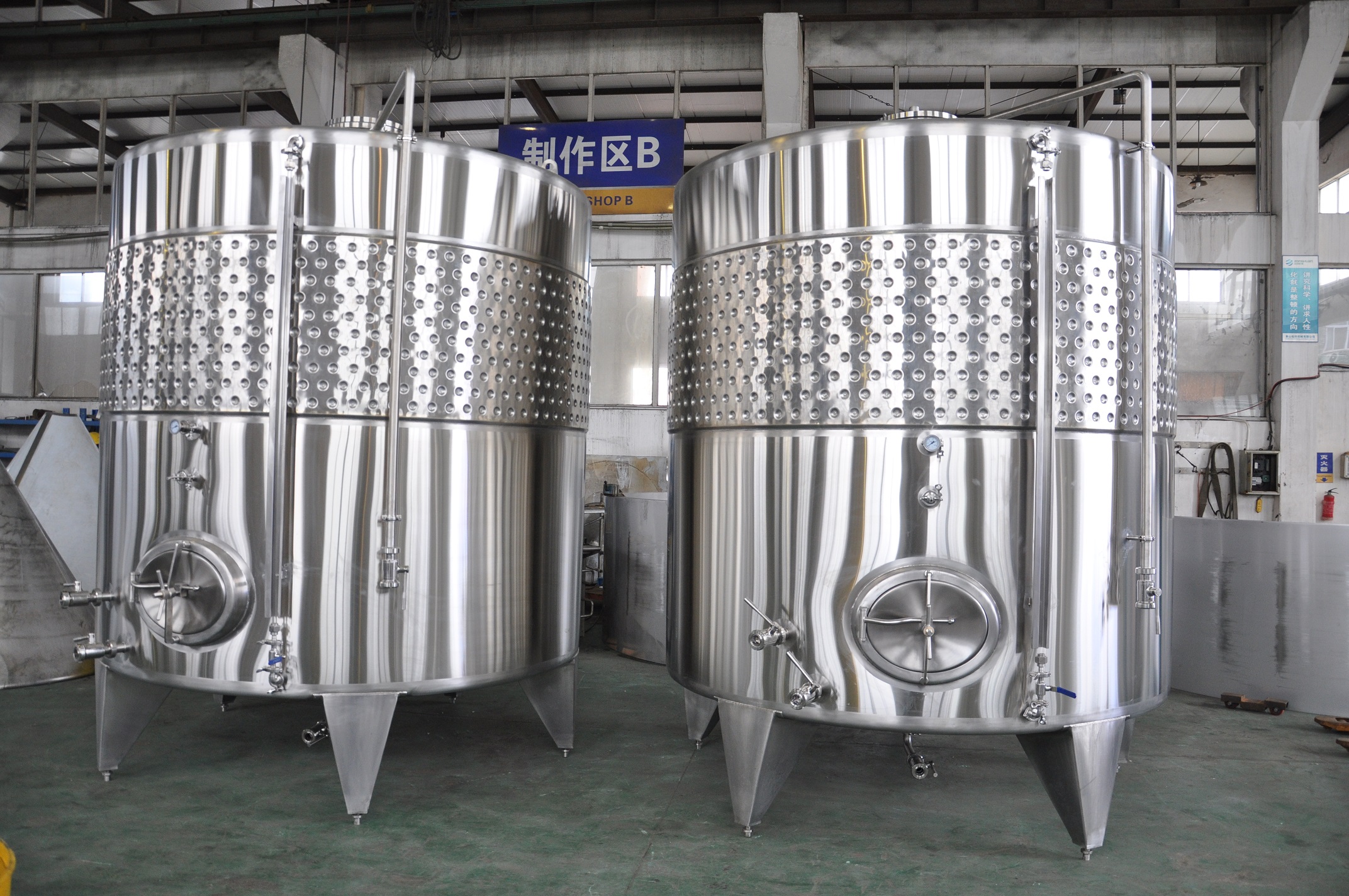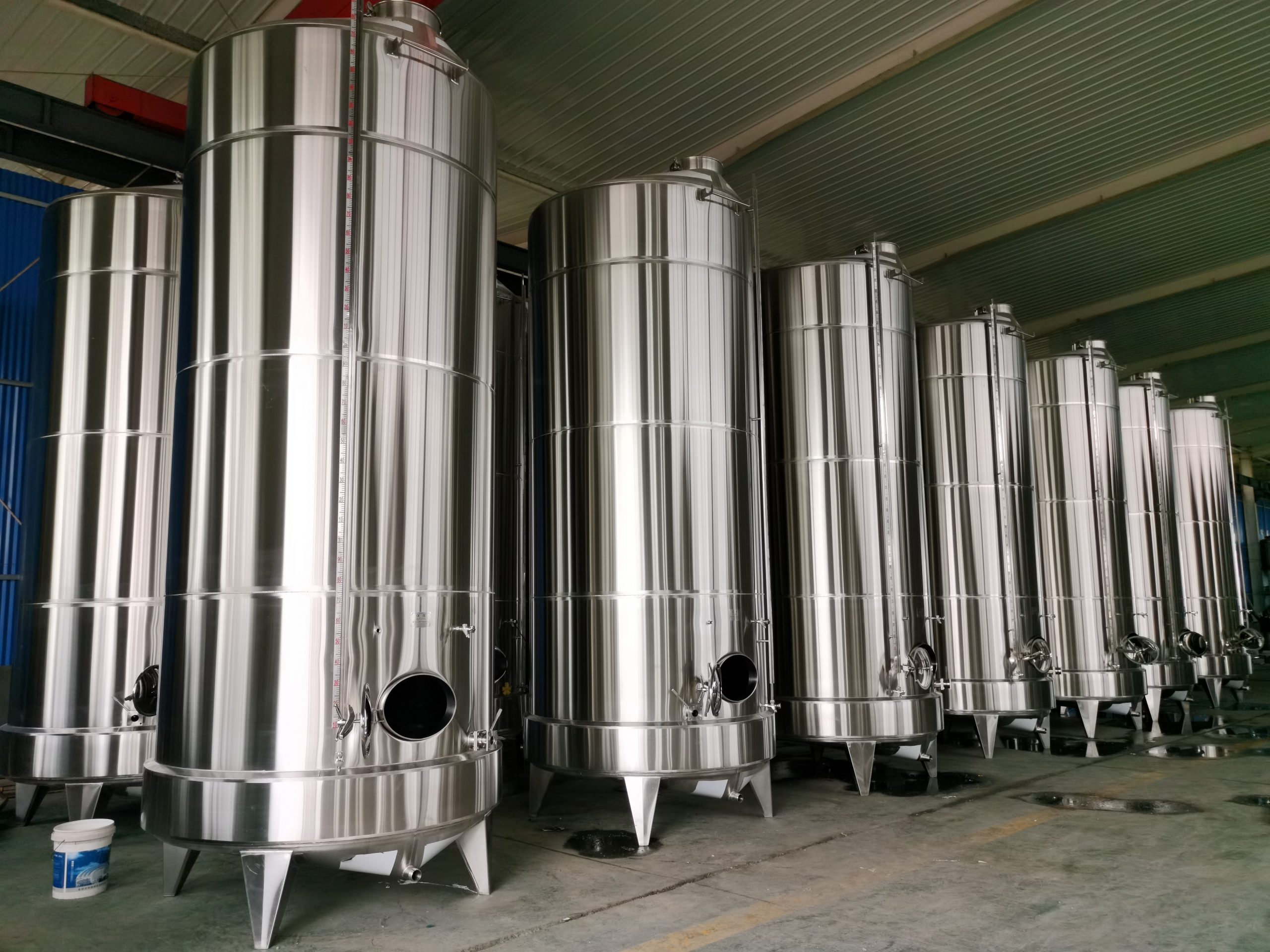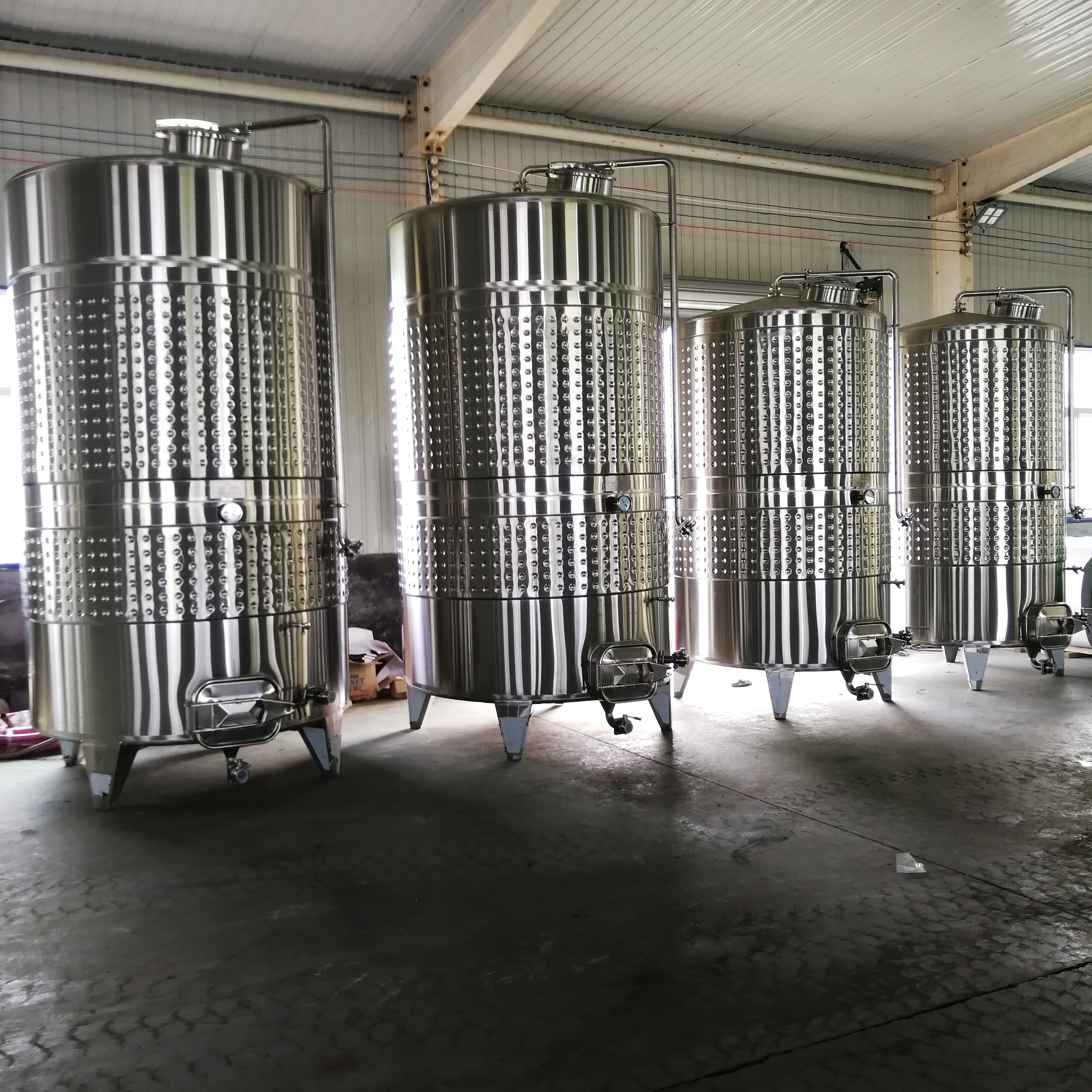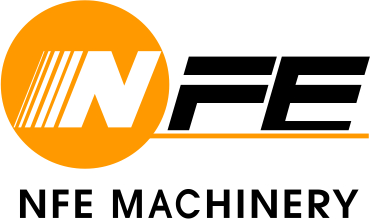
Cider Tank For Cider Making Equipment

Cider fermentation tanks are specialized vessels designed for the fermentation process in cider making. These tanks provide an ideal environment for yeast to convert the sugars in the cider into alcohol and carbon dioxide.
1.What should be considering when choosing the cider tank?
When it comes to choosing a cider tank for cider making equipment, there are a few options to consider. Here are some common types of cider tanks:
Stainless Steel Tanks: Stainless steel cider tanks are a popular choice for both small-scale and commercial cider production. They are durable, corrosion-resistant, and provide excellent sanitation. Stainless steel tanks offer temperature control options, such as cooling jackets or insulation, and come in various sizes to accommodate different production volumes.
Plastic Tanks: Food-grade plastic tanks, typically made from polyethylene or polypropylene, are lightweight, affordable, and easy to clean. They are available in different sizes and are suitable for small to medium-sized cider production. Plastic tanks are less expensive compared to stainless steel, but they may not offer the same level of temperature control or durability.
Oak Barrels: Oak barrels can be used for cider fermentation, particularly for those who desire the traditional character and flavor imparted by wood. Barrels can add complexity and unique aromas to the cider. However, oak barrels require more maintenance, as they need to be periodically cleaned, sanitized, and properly cared for. They also have limited capacity and may not be suitable for large-scale production.
Flexitanks: Flexitanks are large, flexible containers made from food-grade materials, such as polyethylene. They provide a cost-effective solution for bulk cider storage and transportation. Flexitanks can be a convenient option for cider producers who need to move large volumes of cider efficiently.
Glass Carboys:Glass carboys, although less common for larger-scale production, can be used for small-batch cider making. They are transparent, allowing visual monitoring of the fermentation process, and are easy to clean. However, glass carboys can be heavy and fragile, requiring careful handling.
When choosing a cider tank, consider factors such as production volume, budget, temperature control requirements, and desired flavor characteristics. Each type of tank has its own advantages and considerations, so it’s essential to select the one that best fits your specific needs and preferences.

2.Stainless steel cider tank for Cider Making Equipment
A stainless steel cider fermentation tank is a specialized vessel designed specifically for fermenting cider. It provides a controlled environment for the fermentation process and offers several advantages over other types of fermentation vessels. Here are some key features and benefits of stainless steel cider fermentation tanks:
Material and Durability: Stainless steel tanks are constructed from food-grade stainless steel, which is highly durable, corrosion-resistant, and non-reactive. It ensures that the tank won’t impart any unwanted flavors or contaminants to the cider, maintaining its quality.
Sanitation and Hygiene: Stainless steel is easy to clean and sanitize, making it ideal for maintaining a hygienic environment during fermentation. The smooth, non-porous surface of stainless steel prevents the growth of bacteria and facilitates thorough cleaning.
Temperature Control: Stainless steel tanks provide excellent insulation and allow for precise temperature control. They can be equipped with cooling jackets or heating elements to regulate the fermentation temperature, ensuring optimal conditions for yeast activity.
Oxygen Protection: Stainless steel tanks are airtight, which helps prevent oxygen exposure during fermentation. Oxygen can negatively affect cider quality and lead to off-flavors or oxidation. Stainless steel tanks can be fitted with airlocks or closed systems to allow carbon dioxide to escape while keeping oxygen out.
Conical Shape: Many stainless steel cider fermentation tanks feature a conical shape, which aids in the separation of sediment and yeast. The cone-shaped bottom allows the sediment to settle, making it easier to rack or remove clear cider from the top.
Size and Capacity: Stainless steel fermentation tanks come in various sizes and capacities to suit different production needs. Whether you’re a home cider maker or a commercial producer, you can find tanks of different volumes to accommodate your batch sizes.
Additional Features: Depending on the specific tank model, you may find additional features such as built-in temperature controllers, monitoring devices, sampling valves, and racking arms. These features enhance the fermentation process, simplify monitoring, and allow for easy sampling and transferring of cider.
Longevity and Investment: Stainless steel fermentation tanks are a long-term investment due to their durability and longevity. They can withstand repeated use and provide consistent performance for many years. While they may have a higher upfront cost compared to other fermenters, their reliability and quality make them a worthwhile investment for serious cider makers.

3.How to choose the best quality cider tank for cider making equipment?
To choose the best quality cider tank for your cider making equipment, consider the following factors:
Material: Opt for a cider tank made from high-quality food-grade materials, such as stainless steel or food-grade plastic. These materials are durable, non-reactive, and resistant to corrosion, ensuring the integrity and safety of your cider.
Construction and Welding: Examine the construction and welding quality of the tank. Look for smooth and polished welds that minimize the risk of bacteria or contaminants getting trapped. Sturdy construction ensures the tank’s durability and longevity.
Size and Capacity: Consider the size and capacity of the cider tank based on your production needs. Determine the volume of cider you plan to produce and choose a tank that can accommodate your batch sizes. Ensure it has enough headspace to allow for proper fermentation and expansion.
Temperature Control: If temperature control is important for your cider making process, choose a tank with options for cooling or heating. Look for tanks with integrated cooling jackets or the ability to attach external temperature control devices.
Conical Shape or Racking Arm: A conical cider tank or one with a racking arm can make the racking and clarifying process easier. The conical shape facilitates the collection and removal of sediment, while a racking arm simplifies transferring cider to other vessels.
Sealing and Oxygen Protection: Ensure the cider tank has an airtight seal to prevent oxygen exposure during fermentation. Look for tanks with reliable seals and options for attaching airlocks or pressure relief valves. Oxygen protection is crucial for maintaining the quality of your cider.
Easy Cleaning and Maintenance: Choose a cider tank that is easy to clean and maintain. Look for smooth surfaces, removable fittings, and easy access to all parts of the tank for thorough cleaning and sanitation. Consider tanks with features like removable lids or manways for convenient access.
Reputation and Reviews: Research different brands and read reviews from other cider makers. Look for reputable manufacturers with a track record of producing high-quality cider tanks. Pay attention to feedback regarding construction quality, functionality, and customer satisfaction.
Budget and Value: Consider your budget and the value provided by the cider tank. While quality should be a priority, ensure that the tank fits within your budget and offers a good balance between performance and cost.
Warranty and Customer Support: Check if the manufacturer offers a warranty or guarantee for the cider tank. A warranty demonstrates the manufacturer’s confidence in their product. Also, ensure that the supplier provides reliable customer support in case you have questions or encounter issues with the tank.
By considering these factors, you can choose a high-quality cider tank that meets your specific needs, supports efficient fermentation, and contributes to the production of excellent cider.

4.Installation and maintenance
Proper installation and maintenance of cider making equipment are essential for ensuring optimal performance and longevity. Here are some general guidelines for installing and maintaining cider making equipment:
Installation:
Read the manufacturer’s instructions: Familiarize yourself with the equipment’s installation instructions provided by the manufacturer. Follow the recommended steps to ensure proper setup.
Clean and sanitize: Thoroughly clean and sanitize all equipment before installation. This helps remove any contaminants or residues that could affect the quality of your cider.
Assemble according to instructions: If the equipment requires assembly, carefully follow the instructions provided. Pay attention to any specific connections, fittings, or adjustments that need to be made.
Check for leaks: After installation, check for any leaks in the equipment. Ensure that all connections are properly tightened and secure. Leaks can compromise the fermentation process and lead to contamination or loss of cider.
Maintenance:
Regular cleaning and sanitation: Clean and sanitize all equipment before and after each use. Follow the recommended cleaning procedures provided by the manufacturer. Use food-grade sanitizing solutions to ensure a hygienic environment for your cider.
Inspect for damage: Regularly inspect your equipment for any signs of damage, such as cracks, scratches, or wear and tear. Address any issues promptly to prevent further damage or compromise in performance.
Replace worn or damaged parts: If any components of your equipment become worn, damaged, or malfunctioning, replace them as necessary. This may include seals, gaskets, airlocks, or tubing. Using compromised equipment can lead to contamination or inefficient fermentation.
Lubricate moving parts: If your equipment has moving parts or mechanisms that require lubrication, follow the manufacturer’s recommendations for lubrication intervals and use food-safe lubricants.
Store properly: When not in use, store your equipment in a clean and dry environment. Protect it from dust, moisture, and extreme temperatures that could affect its integrity.
Follow maintenance schedules: Some equipment may have specific maintenance schedules or requirements. Consult the manufacturer’s instructions or guidelines for any recommended maintenance tasks, such as deep cleaning, calibration, or replacing certain parts.
Seek professional assistance if needed: If you encounter complex issues or are unsure about specific maintenance tasks, don’t hesitate to seek professional assistance. Contact the manufacturer, a cider making expert, or a specialized equipment technician for guidance.
By following these installation and maintenance guidelines, you can ensure the proper functioning and longevity of your cider making equipment, resulting in consistent and high-quality cider batches.

Thank you for reading this article about cider tank for cider making equipment. If you’re looking for a high-quality, durable, and easy-to-use cider making equipment, we recommend the brewing equipment brand NFE Machinery company, NFE brewing equipment has good reputation for overseas market, Selling equipment is only the beginning of cooperation between NFE and you. Our Real Purpose is to help you set up the brewery and we grow together!




















